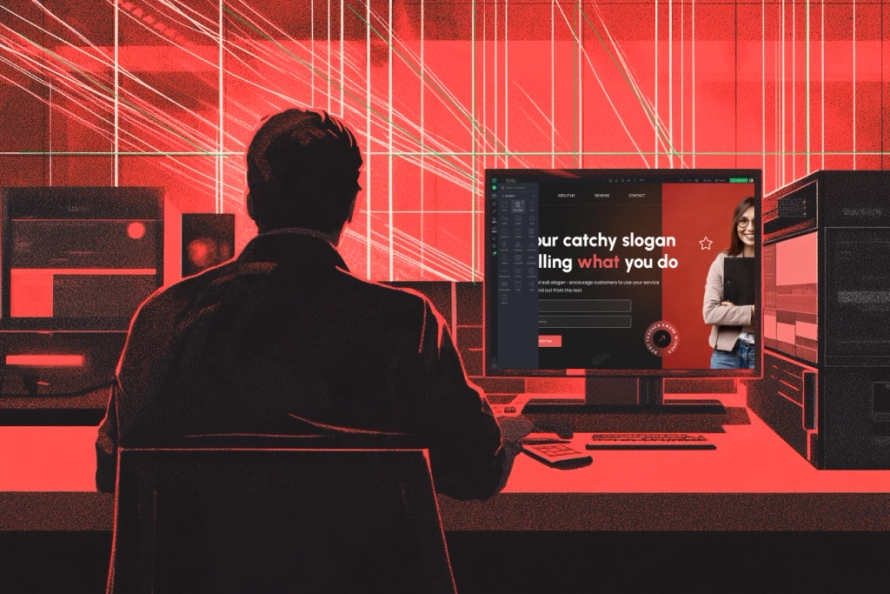Web Design London Ontario for Modern Business Sites
Web Design London Ontario for Modern Business Sites
Blog Article
Exactly How to Successfully Integrate Looks and Capability in Internet Layout
When designing an internet site, you require to strike an equilibrium in between aesthetic appeals and functionality. It's not simply about looking excellent; your style needs to likewise serve a purpose and guide individuals properly. By concentrating on simplicity and instinctive navigation, you can develop an engaging experience. Yet what aspects absolutely enhance functionality while keeping aesthetic allure? Let's explore the essential principles that can bring about an unified mix of appeal and function.
Recognizing the Relevance of Aesthetics and Performance
When you make a web site, recognizing the balance between looks and performance is crucial for developing a reliable individual experience. A visually enticing site grabs attention, but it's the capability that maintains customers engaged. Site visitors will rapidly shed passion and leave.Consider your target audience and what draws them in if your website looks fantastic yet is challenging to browse. You wish to create a style that shows your brand name while making certain simplicity of usage. Structured designs, intuitive navigation, and clear phone calls to activity can improve both aesthetics and functionality.

Concepts of Effective Web Design
To produce an effective web layout, you need to comply with numerous essential principles that boost both user experience and aesthetic allure. Prioritize simplicity; a tidy format assists individuals browse easily. Use a constant color pattern and typography to maintain comprehensibility across your website. This fosters familiarity and trust.Next, guarantee your layout is responsive. Individuals access internet sites on different gadgets, so your style must adjust flawlessly. Take note of visual power structure; highlight important aspects with positioning, shade, or dimension to guide individuals' focus.Finally, integrate enough white area. It prevents mess and makes material a lot more absorbable. Remember, reliable website design balances aesthetics and functionality, so every design selection should serve a function. By following these principles, you'll create a site that's not only visually attractive but also easy to use, eventually keeping site visitors involved and motivating them to return.
Focusing On Individual Experience
When focusing on individual experience, you'll wish to begin by understanding what your users truly need. Simplifying navigating layout can make a significant distinction in just how quickly they locate what they're seeking. Improving aesthetic pecking order helps guide their focus to the most crucial components on your site.
Comprehending User Requirements
Recognizing user needs is important for producing an engaging web experience that maintains site visitors coming back. To accomplish this, you must determine the objectives and choices of your target market. Begin by performing individual research, like surveys or meetings, to collect understandings on what customers worth most. When connecting with similar internet sites, pay focus to their discomfort factors and difficulties. This info enables you to tailor your layout, making sure capability lines up with customer expectations. Additionally, consider producing customer personalities that stand for various sections of your audience, helping you imagine their requirements during the style process. When you focus on understanding customer demands, you develop a website that not just looks great but likewise supplies a smooth, pleasurable experience that promotes loyalty.
Simplifying Navigating Layout

Enhancing Aesthetic Hierarchy
A solid visual power structure is necessary in directing users via your internet site and guaranteeing they involve with key material. To accomplish this, utilize shade, size, and spacing strategically. Make crucial components like headings bigger and bolder than body message, drawing attention instantly. Utilize contrasting colors to highlight calls to activity, encouraging clicks. Additionally, use sufficient white space to separate areas, making material absorbable and inviting.Consider the circulation of info; prepare components logically, leading customers' eyes from one indicate the next. Usage visual signs, like lines or arrowheads, to direct interest. By prioritizing visual hierarchy, you enhance customer experience and boost the chance of conversions, guaranteeing your website is both aesthetically pleasing and functionally reliable.
Color Concept and Its Influence On Functionality
While picking the right shades for your website might appear like a small information, it greatly affects functionality and user experience. Color influences exactly how individuals view details and can prevent or boost navigation. Contrasting shades can assist important components stand out, making it simpler for visitors to find what they need.Additionally, take into consideration the psychology of colors: blue usually motivates count on, while red produces necessity. Recognizing your target market can assist your shade selections, assuring they resonate well.Moreover, consistent color pattern help develop brand name identification, making your internet site much more remarkable. Be cautious-- as well several shades can overwhelm individuals. Adhere to a restricted combination that complements your material and preserves clarity.Incorporating ease of access is likewise vital; validate your color mixes are pleasant for those with aesthetic disabilities. By thoughtfully using color theory, you'll enhance functionality and develop an extra appealing customer experience.
Typography: Balancing Style and Readability
Shade selections established the phase for your internet site, however typography plays a similarly vital function in boosting customer experience. You desire your text to communicate plainly while also mirroring your brand's character. Start by choosing fonts that are not just attractive however also clear. Sans-serif typefaces usually function well for electronic displays, as they're much easier to read at various sizes.Maintain a hierarchy by utilizing various typeface sizes and weights; this overviews customers through your material easily. Consider line spacing and letter spacing; too limited can irritate readers, while too loose can interfere with the flow. Limitation your typeface options to 2 or 3 to maintain the style cohesive.Finally, constantly check your typography across various tools and web browsers. What looks great on one screen might not on another. Balancing style with readability warranties that your message resonates, maintaining click here your audience notified and engaged.
Receptive Style: Making Looks Deal With All Devices
To ensure your website looks terrific on any gadget, you'll require to embrace responsive style concepts. This technique guarantees your website adapts to different display dimensions, supplying an ideal individual experience. Begin by utilizing fluid grids and adaptable pictures that scale seamlessly. Rather than repaired measurements, go with percentages and relative units, enabling your format to adjust dynamically.Next, execute media queries in your CSS. These allow you apply different designs based upon device features, like display size. This means, you can maintain aesthetic allure while guaranteeing functionality.Don' t neglect regarding touch targets; ensure buttons and links are very easy to tap on smaller screens. Focus on crucial material, so individuals can conveniently navigate your site despite their device. By concentrating on these elements, you'll create an interesting, visually appealing experience that fulfills the needs of all individuals, whether they get on a desktop, tablet computer, or smartphone.
Carrying Out Functionality Testing for Continual Enhancement
To improve your website design, you need to set clear use goals that line up with customer needs. By carrying out individual examinations, you can collect beneficial comments on how actual individuals connect with your site. Analyzing these outcomes will aid you make notified renovations and produce a more efficient user experience.
Defining Use Goals
While appearances can draw users in, defining use goals is essential for ensuring their experience stays seamless and satisfying. Begin by identifying what you want customers to accomplish on your website (website design london Ontario). Consider their habits, requirements, and tasks. Are they seeking details, buying, or registering for a newsletter? Establish clear standards to determine success, like task conclusion rates or time on task. Prioritize user-friendly navigating, easily accessible web content, and responsive layout to boost functionality. On a regular basis revisit these goals as individual assumptions advance. By specifying functionality goals, you develop a structure for examining and improving your internet site's performance. This focus on use not only increases customer satisfaction yet also enhances the general effectiveness of your style
Conducting User Tests
Conducting individual tests is important for fine-tuning your website and ensuring it satisfies your target market's needs. Start by recognizing your target individuals and developing an examination plan that details your purposes. Utilize a mix of measurable and qualitative approaches, such as surveys, interviews, and task-based monitorings, to collect complete feedback. Invite participants to browse your website while you observe their communications and note any kind of troubles they experience. Motivate open dialogue to capture their ideas and feelings regarding the design and performance. Keep sessions short and focused, ensuring you cover key locations without frustrating customers. Make sure to document all searchings for, as this details will be important for making informed layout choices that improve both aesthetic appeals and use.
Evaluating Examination Results
How can you properly analyze the results of your usability tests to drive continuous improvement? Beginning by categorizing responses into typical themes. Seek patterns in user behavior that highlight pain factors or locations for enhancement. Usage measurable information, like task conclusion prices and time on task, to measure usability fairly. Do not forget to think about qualitative understandings from individual comments; they frequently disclose underlying issues that numbers can't show. Focus on one of the most impactful findings and produce actionable products for your style team. Remember, it has to do with iterating-- execute changes, after that examination again. This cycle of testing, analyzing, and refining aids you equilibrium visual appeals and performance, guaranteeing your internet site fulfills individual demands effectively while keeping visual allure.
Regularly Asked Inquiries
How Do I Select the Right Shade Combination for My Site?
To pick the appropriate color combination for your site, consider your brand name's character, target market, and emotional influence (website design london Ontario). Use color psychology, produce harmony, and warranty readability. Test combinations to see what resonates best with site visitors
What Tools Can Aid With Website Design Appearances and Capability?
You can use tools like Adobe XD, Figma, and Sketch to boost your website design's looks and performance. These systems use instinctive interfaces, cooperation functions, and pre-made design templates to enhance your creative procedure and enhance your designs.
How Can I Include Animations Without Jeopardizing Performance?
To incorporate animations without endangering capability, focus on refined results that enhance customer experience. Usage CSS animations for smoother interactions, assurance quick load times, and examination on different tools to keep efficiency while adding visual allure.
What Prevail Mistakes to Avoid in Web Design Aesthetics?
When developing, stay clear of chaotic layouts, poor color choices, and irregular typefaces. Don't overlook mobile responsiveness, as it can push away individuals. Verify your design straightens with your brand name, creating a seamless experience that involves site visitors effectively.
Just how Often Should I Update My Web site's Design for Optimal Looks?
You ought to update your site's design every 1-2 years to stay up to date with patterns and maintain optimal aesthetics. Frequently renewing visuals helps involve visitors and guarantees your website stays easy to use and appealing. When you develop an internet site, understanding the balance in between appearances and capability is important for creating an effective individual experience. To create an effective web design, you require to stick to several key concepts that improve both user experience and visual charm. Customers gain access to sites on numerous gadgets, so your layout needs to adjust perfectly. When prioritizing individual experience, you'll want to start by recognizing what your customers really require. Beginning by carrying out customer research study, like interviews or studies, to gather understandings on what individuals value most.
Report this page